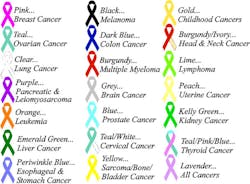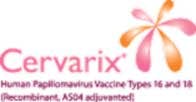The Big "C": What's new?
The “C” word is a daunting one; it evokes fear in most of us. What causes cancer? The answer to this is not a simple one. However, according to the American Cancer Society (ACS), we know that cancer is a complex group of diseases with many possible causes. The known causes of cancer are: genetic factors; lifestyle factors such as tobacco use, diet, and physical activity; certain types of infections; and environmental exposures to different types of chemicals and radiation.(1) This article will explore some of the news around cancer.
There are many different types of cancer, but they all start because abnormal cells grow out of control. Cancers can metastasize through the blood stream, or lymph system. Half of all men and one-third of all women in the U.S. will develop cancer during their lifetimes.(2) We have known for some time that the inflammatory process and the progression of cancer tumors are connected.(3) Many cancers arise from sites of infection, chronic irritation and inflammation. In fact, as far back as 1863, it was theorized that the basis of cancer was at sites of chronic inflammation, in part based because some classes of irritants, together with the tissue injury and subsequent inflammation they cause, enhance cell proliferation.(4) A new retrospective study evaluated the potential association between chronic periodontitis diagnosed through radiographs and oral squamous cell carcinoma (OSCC).(5) Ninety percent of all oral malignancies are OSCC. Survival rate has not changed in the last 50 years, and 50% or more individuals will not survive.(6) We know that chronic periodontitis is a common disease; we see it almost daily. In the study, authors concluded that the monitoring and treatment of chronic oral inflammation may be beneficial in reducing one potential cause of OSCC. They suggested that further clinical studies on oral cancers should include clinical periodontal parameters. As well, the results also found a possible beneficial effect of periodontal therapy that may inhibit the occurrence of OSCC. Due to the high frequency of periodontal diseases worldwide, this finding could be of high clinical relevance. More studies are needed, preferably prospective studies. We also know that some oral cancers are caused by the human papilloma virus (HPV).(7) Cancers caused by HPV are oropharyngeal cancers, most often found in the back of the throat, most commonly in the base of the tongue and tonsils, in the oropharynx. Is it preventable? As oral cancer caused by HPV is considered a sexually transmitted disease (STD), practicing safe sex is a preventive measure to stop the spread of the virus. There are also vaccines that prevent cervical and other less common genital cancers. It is possible that HPV vaccines might also prevent oropharyngeal cancers, since the vaccines prevent an initial infection with HPV types that can cause oropharyngeal cancers.(7) Studies have not yet been done to determine if HPV vaccines will prevent oropharyngeal cancers.
Oral HPV infection is the cause of 40% to 80% of oropharyngeal cancers.(8) A new study showed that poor oral hygiene is associated with oral HPV.(8) In addition to observing the connection between oral health and oral HPV, the study analyzed the interactive effects of oral health, smoking, and oral sex on oral HPV infection. It was a large study with 3,439 participants, using data from the National Health and Nutrition Examination (NHANES) Survey.
Oral HPV infection had a statistically significant association with self-rated overall oral health, independent of smoking and oral sex. The conclusion was that poor oral health was an independent risk factor of oral HPV infection, regardless of smoking and oral sex practices. Public health interventions may wish to promote oral hygiene and oral health as an additional measure to prevent HPV-related oral cancers. As well, individuals have yet one more reason to maintain ideal oral health! Fusobacteria, commonly found in the mouth, cause overactive immune responses and turn on cancer growth genes. They are highly invasive and adherent. Fusobacterium is associated with colorectal adenomas.(9) The results of a 2013 study support a link between the abundance of Fusobacteria in colonic mucosa and adenomas and suggest a possible role for mucosal inflammation in this process.(9) Another study showed that fusobacteria had a molecule on their surface which enabled them to attach to and invade human colorectal cancer cells.(10) The molecule -- FadA -- then switches on cancer growth genes and stimulates inflammatory responses to promote tumour formation. So, if chronic diseases are implicated in cancer to some degree, are we doing enough to prevent, diagnose and treat chronic diseases? New discoveries from the American Journal of Public Health reveal that conducting chronic disease screenings at the dentist could save the U.S. health care system up to $65.3 million over the course of a year, or $20.82 per person screened.(11) The study’s goal was to define the cost savings of medical screenings in the dental office for adults ages 40 and over who had not been formerly diagnosed with chronic health conditions. This included conditions like diabetes, hypercholesterolemia, and hypertension, and the study participants could not have visited a physician’s office in the past 12 months. Findings indicated that, depending on the rate to which referral from dentist to physician occurred; medical screenings for diabetes, hypercholesterolemia and hypertension at the dentist office could save the health care system between $5.1 million to $65.3 million per year.(11)
The bottom line? Oral health care professionals are vital in helping patients not aware of their disease status to seek medical help. Chairside medical screening in a dental setting must be a cost-beneficial strategy that also improves patients’ outcomes, so developing formal referral mechanisms between the dental office and the appropriate medical provider will help facilitate the process. We may just save a life.References 1. http://www.cancer.org/cancer/cancercauses/. 2. http://www.cancer.org/cancer/cancerbasics/what-is-cancer. 3. Coussens LM, and Werb Z. Inflammation and cancer. Nature. 2002 December 19; 420(6917): 860–867. 4. Balkwill F, Mantovani A. Inflammation and cancer: back to Virchow? Lancet 2001; 357:539–545. 5. Moergel M, Kämmerer P, Kasaj A, Armouti E, Alshihri A, Weyer V, and Al-Nawas B. Chronic periodontitis and its possible association with oral squamous cell carcinoma – a retrospective case control study. Head & Face Medicine 2013, 9:39. http://www.head-face-med.com/content/9/1/39. 6. Saman DM: A review of the epidemiology of oral and pharyngeal carcinoma: update. Head Neck Oncol 2012, 4:1. 7. CDC. Human papillomavirus (HPV) and Oropharyngeal Cancer - Fact Sheet. http://www.cdc.gov/std/hpv/stdFact-HPVandoralcancer.htm. 8. Bui TC, Markham CM, Ross MW, Mullen PD. Examining the association between oral health and oral HPV infection. Cancer Prev Res (Phila). 2013 Sep; 6 (9):917-24. Epub 2013 Aug 21. 9. McCoy AN, Arau´jo-Pe´rez F, Azca´rate-Peril A, Yeh JJ, Sandler RS, et al. (2013) Fusobacterium Is Associated with Colorectal Adenomas. PLoS ONE 8(1): e53653. 10. Rubinstein MR, Wang X, Liu W, Hao Y, Cai G, and HanYW. Fusobacterium nucleatum Promotes Colorectal Carcinogenesis by Modulating E-Cadherin/β-Catenin Signaling via its FadA Adhesin. Cell Host & Microbe, 2013; 14 (2): 195. 11. “Effect of Oral Health Professionals on Health Care Dollars Through Chairside Chronic Disease Screenings: A Cost-Benefit Model.”





